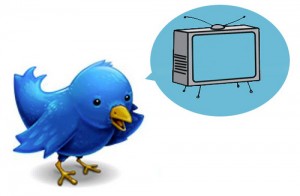
Can you imagine Twitter without TV? Or TV without Twitter? In an era of media and channel convergence, nothing seems to have converged more quickly, or inextricably, than these two channels. A mutual dependency has arisen almost out of nowhere — one that benefits viewers, broadcasters, brands, and advertisers. Consider some of the ways that Twitter is changing television viewing habits and bringing old media into the future.
Real-time viewing
Just when the DVR was threatening to time-shift everyone away from their sets for good, postponing all but the most must-see of TV (i.e., major sport events and award shows), Twitter made television real-time again by plunking the water cooler down onto the sofa cushions. Sure, there’s Facebook and a host of social TV apps. But arguably it’s Twitter, and viewers armed with a battery of laptops, smartphones, and tablets, that has truly relegated the TV set to the status of “second screen.” This has time-shifted viewing as closely back to real-time as it’s ever going to get, as viewers discuss shows with friends, family, hosts, presenters, and the world at large. No DVRs? Advertisers (and broadcasters) don’t hate this.
Lean back/lean forward: Which is which?
Eons ago, when I worked in television (we’re talking mid-’90s), the difference between TV and online was described as lean back vs. lean forward. Consumers were in one mode or the other (i.e., passively viewing on the sofa or actively typing at a desk). The distinction is all but laughable now. Twitter has contributed immensely to an active, engaged, participatory television audience. Advertisers don’t hate this.
Higher ratings
Live chats on Twitter with talent from the show “Bad Girls Club” increased tune-in for the show on Oxygen by 92 percent. On the West Coast, where the chats were not initially available (presumably for time zone reasons) tune-in was up only 14 percent. This is only one of dozens of anecdotes of increased activity, engagement, and boosted ratings — thanks to the immediacy and buzz generated not only by Twitter, but by pulling other forms of social marketing into the mix, such as images and videos. Again, it’s good for everyone in the ecosystem: viewers, Twitter, the broadcaster, and advertiser.
Greater advertiser reach/targeting at little incremental cost
Compared to the cost of a TV buy, advertising on Twitter is a relative bargain. Arguably, Twitter’s acquisition of Bluefin earlier this year can help those advertisers even better target audience segments than broadcast can, at lower cost for better messaging resonance. Another win-win.
Please read the rest of this post on iMedia, where it originally published.
Image credit: arcticpenguin
